Green Steel Trash
Tagged: bike diy projectAs is probably plainly obvious to anyone who has spent any time browsing this site, most of my bike stuff (and general project stuff) comes from back alleys and thrift shops. I generally just take whatever I can find and work with it.
This would probably work better if I wasn’t tall (around 6'2" or 188cm) since the average trash bike is sized for the average person. But more on that later.
I was walking home from work a few weeks back when a bike caught my eye. It was your standard affair - leaned up against a fence as if to say ‘Someone PLEASE give this thing a home. It’s good - but we can’t keep it.’ It was missing its wheels (they had probably been stolen) and was in generally poor shape. The (single) cottered crank suggested it was a slightly older model, and that the owner had likely tried to disassemble it and had given up. I don’t blame them. Cottered cranks always get stuck.
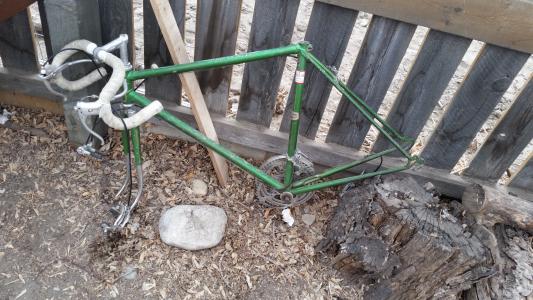
Whenever I see a bike in the trash I usually poke at it a bunch, look around, and do some soul-searching to decide whether or not to take it home. The deliberation can take a long time, depending. I’ve gotten to the point where I will no longer take lower-end or even middle-end mountain bikes with 26" wheels, since they’re the most common type of bike I find, I have a massive pile of parts, and I don’t particularly like riding them.
Vintage steel bikes are probably second place. I’ve got a decent pile of ancient derailleurs and old style drop-bar levers lying around. But I’m still looking for a nice old road bike frame.
I deliberated, and went home without it. I decided I’d think on it, and if I still wanted it the next day, I’d come back and bring it home.
Long story short, I did. Even though it was probably too small for me, and not really what I was looking for. I don’t know what’s wrong with me either. I have a problem, but at least I don’t have an expensive problem.
Besides, it was a beautiful bike. A Motobecane Mirage - a middle spec road bike from the 70s or 80s. The steel was nice, the geometry was pretty, and the paint had a lovely scuffed patina.

Taking the bike apart was reasonably easy. One of the cottered crank arms was missing, and so instead of trying to detach the other, I just unscrewed the bottom bracket and took the crank and chainring out still attached to the spindle. I was going to throw all that stuff out anyways, no sense spending the effort of trying to un-stick a cotter pin.
My plan was simple - I’d assemble the bike in the most minimal way I could, using parts from my fixed gear. If I liked riding it, I’d keep one frame as a fixie and build the other into a lightweight road bike.
I started digging out parts - it was easy since my fixie was disassembled for winter, and all the parts were tucked away neatly under my desk.
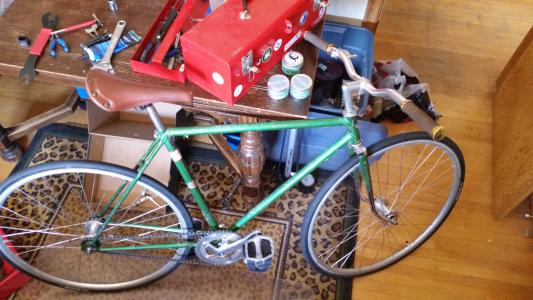
The parts that came off this new frame were pretty standard fare - I did some sorting through my parts bin. I figured I’d pick exactly one spare set of vintage parts - whatever was highest spec and in the best condition. Some of that comes down to personal preference of course. I like metal more than plastic, even though some vintage plastic parts are apparently higher-end.
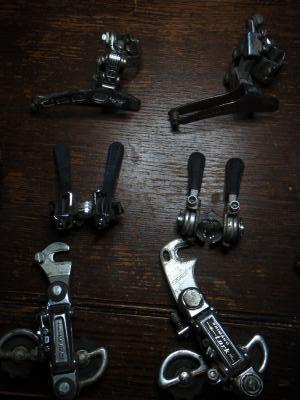
The rest of the parts I donated to my local bike co-op, or tossed in with the scrap metal if they were too worn out.
I was delighted when I found out that the frame took a square tapered enclosed bottom bracket from my parts bin with no problem. All in all, it was an incredibly easy build.
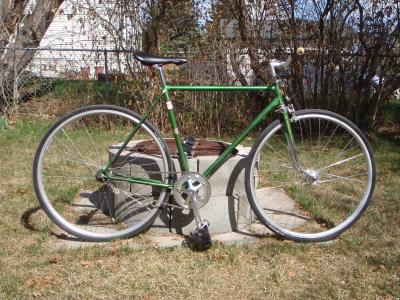
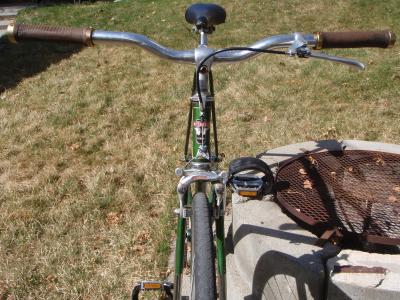
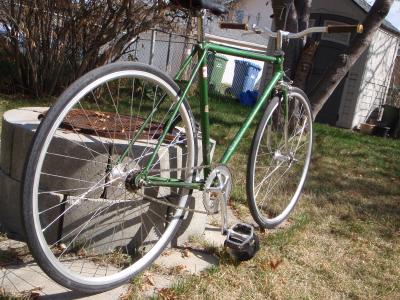

It’s quite attractive, I love the green, and it rides great.
But it’s way too small. So I’m taking it apart and donating the frame.
Oh well.